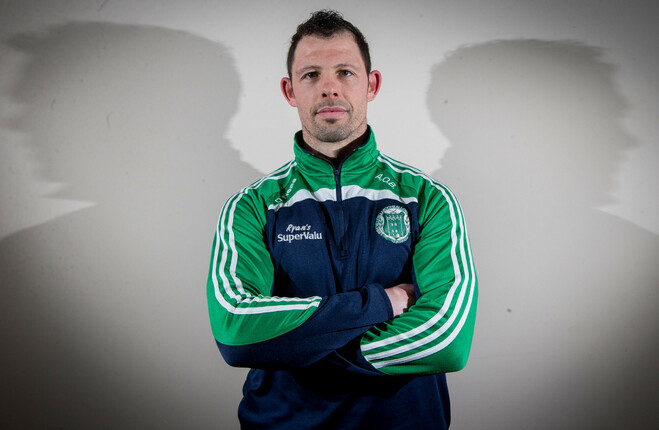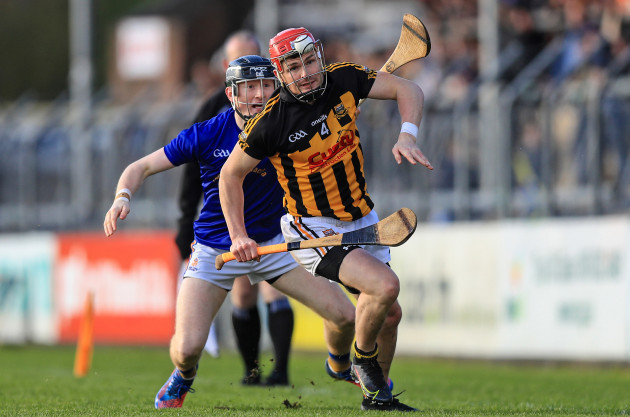THE BEST APPROXIMATION Paul Flanagan could give to describe the feeling of waking up after playing in the epic Clare-Limerick Munster Hurling final? It was like being in a minor car crash.
If so, Adrian O’Brien will take the role of calibrating the shock absorbers and reinforcing the chassis as he takes over as Banner strength and conditioning coach for 2023.
Brian Lohan didn’t have to look far to find O’Brien. Flanagan, the All-Star nominee who didn’t play senior inter-county hurling until the age of 28, hails O’Brien in all media interviews with helping him overcome injuries and reach the required physical level for his belated rise to the top tier of the game. As O’Brien told him: ‘If the chassis isn’t right, we’re going nowhere.’
Flanagan got O’Brien on board with Ballyea and in 2022, he performed the additional role of hurling coach alongside his strength and conditioning duties. As if that wasn’t enough (even after a summer working with Billy Lee’s Limerick footballers), down in Cork O’Brien was carrying out the same dual role for St Finbarr’s: drilling their young squad for the physical battle and sharpening them the hurling tools to put the scores on the board.
It made for a unique Clare-Cork double celebration for O’Brien when both clubs won their county titles although their subsequent meeting in a Munster semi-final was a tough pill for him to swallow having invested so much into the two teams. O’Brien chose to watch it from home, rather than go through the complex emotions of viewing his teams bid to put the other to the sword in person.
During that week off, the Kilmallock native took time out to chat with The42 about his views on hurling and the coaching philosophies that underpin his work with the likes of Ballyea and the Barrs.
Hurling – a game of moments
“If you look at the game of hurling and break it into moments, there’s either one of five things that are happening: you’re either attacking, defending, transitioning from attack to defence, from defence to attack, or there’s a contest for possession.
“Each one of those moments would have a defined physical, technical, tactical, and psychological skillset that you’re trying to develop in each one of these.
“Then, from an S&C standpoint, you’re trying to do one of three things. You’re trying to allow the athlete produce more force, then provide the athlete with the skills to produce that force in the right direction, and then allow them the affordances so they can access the energy systems that they require for their position for the sport they play.
“Everything else is fluff around that.”
Principles of attack and defence
“You look at game moments and you break down those moments and then you will have certain principles that underpin those moments.
“For example, at a basic level, if you’re looking at attacking, you’re trying to create space. So you’re trying to preserve space somewhere on the field so you can create space.
“If you’re defending, you’re trying to compress space and close space. Then you will have certain principles and coaching cues that would underpin those macro moments of a game. That’s the way I would look at the game really.”
Creating a system of play
“Any team sport is around two things. You’re trying to open space on one side of the field and close space on the other side of the field and that’s the reality of an evasion-based team sport.
“Why do teams play a sweeper? They play a sweeper because you’re compressing more space in the defensive zone. You now have an overload of a defender so now there’s less space and less time on the ball.
“The other side of that is I remember when the sweeper came out first, some teams would follow the sweeper up so then if you follow the sweeper up, you’ve compressed the space even more and you’ve opened up more space behind. They’re the principles you’re really looking at.
“It would always be based on the players that are available to you. You can’t have a defined system of play if you don’t have the personnel to implement it.
“First, you’d always get to know your people and go from there.”
A players-first philosophy
“For me, getting to know players, building relationships with players, that’s a really important concept in my eyes.
“To me, I would prefer to have a 10-to-15-second chat with every player before I put a cone on the field and ask them how they are, how their day has been. We only look at training loads but there’s also life loads and you’ve got to know your players.
“This is where I couldn’t compliment Ger [Cunningham, St Finbarr’s manager] and Robbie [Hogan, Ballyea manager] enough. They were unbelievably trusting in what we were doing.
“If I thought we needed to pull them a little bit, we’d pull back sessions. If I said we needed to push a little bit, they put full faith in what I had been doing.”
Communication, communication, communication
“Coaching is both an art and a science, that’s the reality of it. We lean on the science to a point but we also have to use our coaching intuition. We have to use our eyes and communication is something that I’m always trying to consistently encourage.
“I always assume that the message I’m delivering isn’t landing so I’m just finding different ways to reinforce that message through questioning, through repetition, through the use of video, it might be handouts, it might be getting one of the selectors to deliver the message.
“We’re just constantly reinforcing those messages to the players.”
Putting statistics in context
“Stats can be very, very useful but everyone has their own way of deriving what they want from statistics. I’m always a little bit cautious with stats because what we measure we like to develop.
“For example, I’d always like to look at things in context of the game. So we could look at total tackles, for example, and then we could have an assumption that if we tackle more we’re going to win the game but that might not necessarily be the truth.
“I think it was Paolo Maldini who used play for AC Milan that averaged about 1.5 tackles in a game [former Chelsea director of football Mike Forde reckoned it was actually 0.5 tackles per game]. And his famous quote was ‘If I’ve to make a tackle, I’ve already made a mistake’ because he would read the game so well.
“It’s the same as GPS data. I’ve never seen the player to have the highest GPS outputs to have the biggest influence on the game. It generally doesn’t happen. I’m not saying that it’s not important. There’s a minimum that you have to be able to accomplish but I don’t like to isolate any one thing.
“I like to look at things in more of a contextual situation where you’re marrying physical, technical, tactical, and trying to develop or trying to assimilate what you can based on that model.”
Managing dual players
“Being in the dual scenario, it’s challenging in one way because lads are going week on week.
“If you were just to look at it with the strength and conditioning hat, you’re just monitoring training loads, you’re making sure that lads aren’t being overloaded at different parts of the week, you’re trying to keep the communication lines as crystal clear as you possibly can with the football side of the house.
“And then you just put the player in the centre of the decision-making process all the time because the reality of it is that it’s the player who has to go under that stress week in, week out both emotionally and physically because you’re trying to lift yourself week in, week out which is as big a challenge as the physical drain.”
Avoiding injuries
“The first thing you do when you get involved in a sport is you do a needs analysis of the sport. You look at what’s the common injury profile of the sport.
“We know in hurling and football it’s calves, hamstrings, groins, and quad tears, then a big part of your strength programming is making them robust enough.”
Designing your sessions
“When you have your session design and you’re looking at your game model and the components of the game you’re trying to develop and then you also look at it from an S&C standpoint and what underpins all that is the loading: how you manage volume and intensity throughout the week, how you schedule your week, how you define your training days, and then your system of monitoring the players’ loads.
“Then you’re starting to develop a methodology about how you do your business.”
Integrated hurling and S&C approach
“If you have a very definite defined vision or model of how you see the game first and foremost, and if you have some way of sharing that with the players and integrating the loading from a physical standpoint, I think it’s a big benefit to be able to manage both.
“You have the physical, the technical, the tactical and the psychological components of how you’re trying to develop a team and if you can get the physical, the decision-making, the patterns of play, and if you can do that in more of an integrated approach, I think that’s it’s beneficial.
“It’s been a challenge but it’s been extremely enjoyable.”
Making it fun
“Fun has to be a big central part of what you do. We lose sight of that a small bit, that these lads get up for work again, whether it be students or farming or teaching or engineers, they all get up for a day’s work.
“The reality is that if you ask any young lad up and down the length and breadth of the country why do they play hurling and football, they’ll say because I want to meet my friends and have fun.
“Sometimes, as coaches, we can get a little bit removed from that because we’re in to do a job but the reality is that all these players, fun has to be a central tenant of why they’re there, and we have to facilitate that in our coaching.”
Getting the foundations right
“When you get to adult grade, the work is done. Okay, you’re coaching but you’re just facilitating. The skill work has been done at U8, U10, U12, U14, U16, minor, U20 level with these players. It’s all those coaches back along the clubs that should get the majority of the credit.
“Adult level, when I come in, you’re managing training loads, you’re making sure lads are fit to do what they love doing which is playing the sport, you’re building relationships with them, you’re developing a game model, a system of play.
“You have a training design that will complement that and off you go.”

